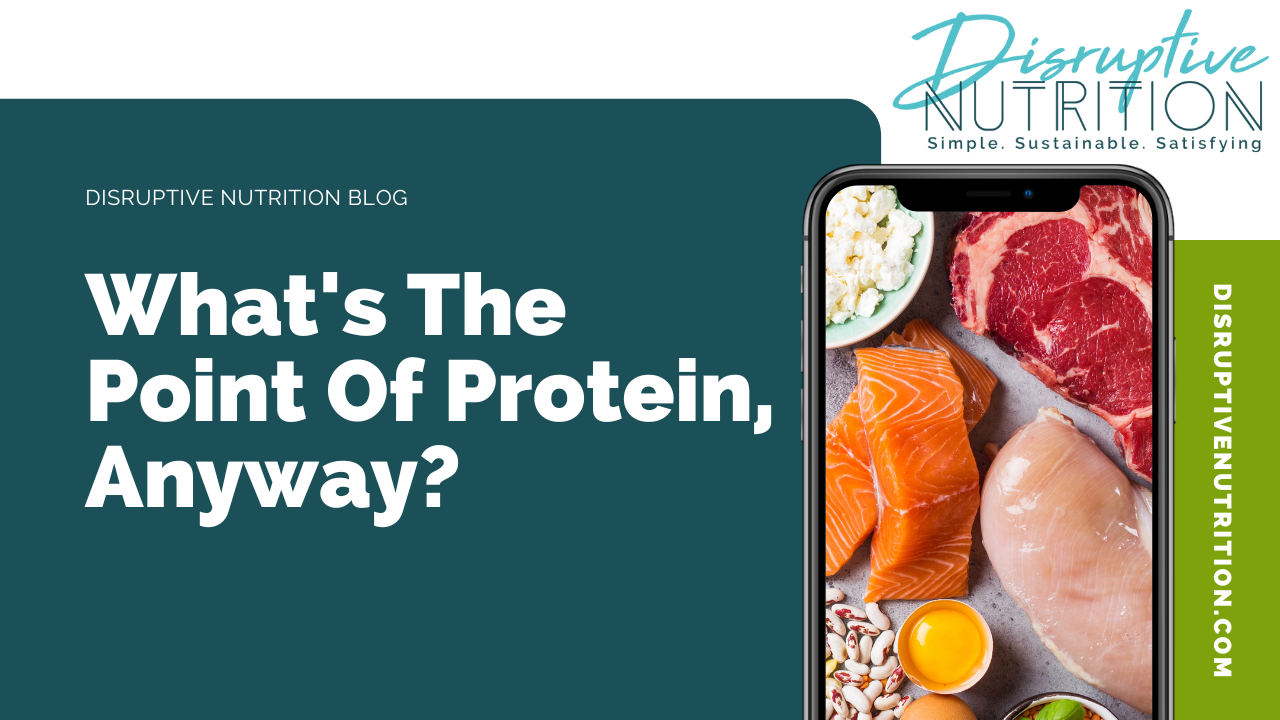What’s The Point Of Protein, Anyway?
Jun 23, 2020
I was recently out at a restaurant (I know, right??? It was outdoors…) and came across a couple who were ordering drinks. The man ordered protein water and the woman said, “No protein for me, he's the one who lifts weights, not me. I'll have a Coke.”
I SOOOO wanted to say something, but thinking it would cause more harm than good, I decided to bite my tongue and write about it instead.
We ALL need protein. Yes, even women. Yes, even if you don't work out.
Protein is an indispensable part of a healthy diet – it is much more than the stuff that bodybuilders eat to build muscle and “bulk up”. Protein is actually a macronutrient, a fundamental nutritional compound that our bodies need to survive, it literally provides the building blocks of life.
Next to water, it’s the most abundant substance in the body… every cell and most bodily fluids contain protein. As you know it helps to build muscle, but did you know that protein chains can also be chemical messengers? They’re used in sleep regulation, aid in energy regulation, making and repairing cells, and strengthen the immune system – just to name a few jobs.
And as we get older, women ESPECIALLY, need protein because aging bodies process protein less efficiently and need more of it to maintain muscle mass and strength, bone health, and other essential physiological functions.
So how does the protein we eat transform from a healthy lunch into a healthy body? The first step is converting the consumed protein into amino acids – this happens as part of the digestion process. Next is the rebuilding of the amino acids into usable protein chains. And this is where it gets a little tricky… In all, there are 20 distinct amino acids. Using these 20 amino acids the body then forms an abundant array of protein chains to carry out a diverse assortment of jobs. Well, that doesn’t sound too bad, right? Just eat some protein every day and we’re good to go … not so fast.. not all protein is created equal and we need all 20 amino acids to make all of the necessary combinations needed within the body.
Let me explain:
In the world of amino acids, the 20 different types can be separated into 2 categories: essential – those that must be consumed through our diet (there are 9) and non-essential those that are synthesized by the body (there are 11). Don’t let the name “non-essential” fool you – both are extremely important to the functions of the body.
Next, when it comes to consumable protein – where you’re getting your essential amino acids – there are two different types … complete and incomplete. A complete protein is one that contains all 9 of the essential amino acids, whereas an incomplete protein is low or lacking in one or more.
Why is this important, you may ask? Remember that the body uses amino acids in different combinations to perform different functions. If something is missing, the protein chain cannot be assembled, and the function cannot be carried out. The body doesn’t store proteins the way that it stores fats or carbohydrates. It is important to consume protein at every meal throughout the day, providing your body with the elements that it needs.
So, where do we get the protein? Complete proteins typically come from animal products such as beef, chicken, fish, dairy, or eggs but can also be found in a few plants based sources such as soy, buckwheat, chia, and quinoa. Incomplete proteins are found throughout the plant world: nuts & seeds, whole grains and beans, primarily.
Bear in mind, not all proteins are created equal – complete proteins provide all of the essential amino acids – making them readily available for the body to use. As mentioned earlier, incomplete proteins do not – if all of the needed components are not available, the task cannot be completed. But low and behold, nature does work in incredible ways, certain combinations of foods complement each other and can, in turn, provide the complete essential amino acid profile. These combinations are nuts/seeds with whole grains (peanut butter on whole-grain toast), whole grains with beans (hummus and pita), and beans with nuts/seeds (barley and lentil soup). Taken separately these are each incomplete – but eaten together and voila – complete.
If you are not eating sources of complete proteins, it is important that you incorporate a variety of plant-based proteins into your diet.
Building complete proteins become a bit tricky – especially when you are trying to balance your protein, fats, and carbs. As you build you may create a complete protein, but you are also increasing the number of carbohydrates and or fat that you’re ingesting, this should definitely be considered when meal planning. Read your labels!
It is vital to provide your body with complete proteins on a daily basis, it’s an imperative part of a healthy diet. Taking the time to learn about the protein that you are consuming is time well spent, your body will thank you!
For more info on vegetarian protein options, visit our Disruptive Nutrition founder, Carrie Lupoli’s blog all about it! CLICK HERE to read now!
Coach Michelle
Coach Michelle Stefan has been with Disruptive Nutrition since its inception and is an amazing supporter of women's health…especially for women over 50! CLICK HERE to read more about Michelle!


